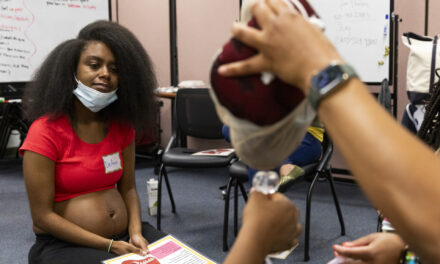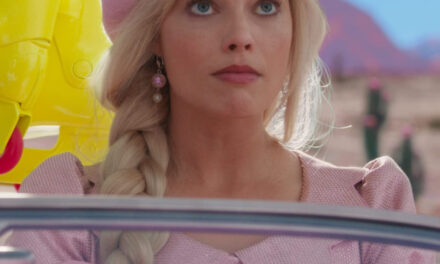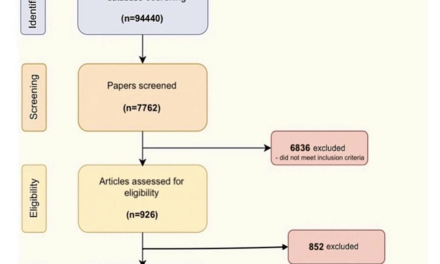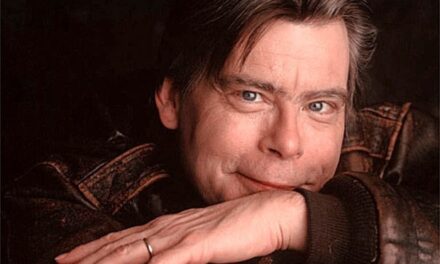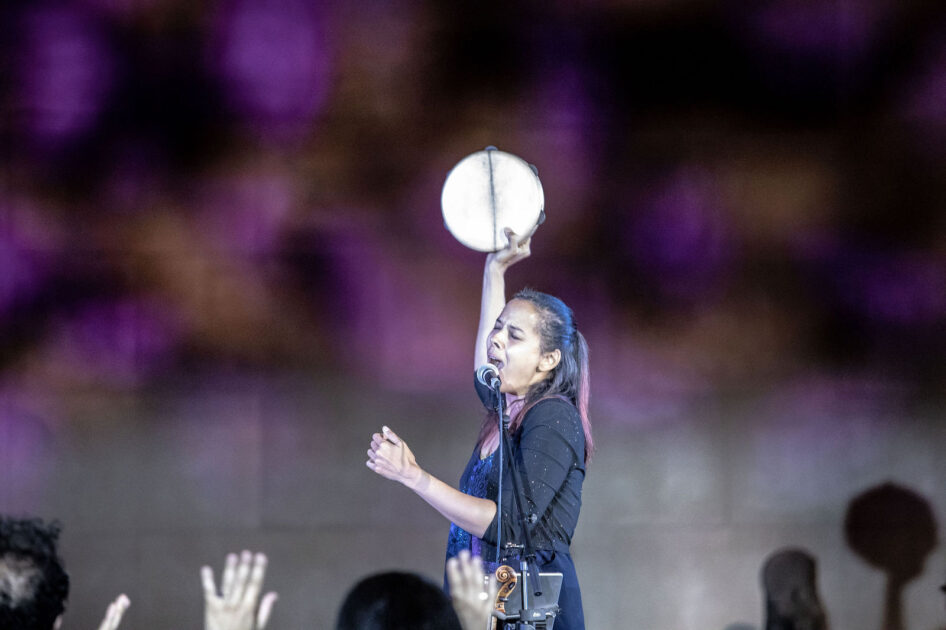
Growing up in the Deep South,
I was never at a loss for the sound
of a man’s voice talking. Their voices
poured forth fire and brimstone
from the pulpit, showered directives
down at children over the school
intercom, cajoled from the campaign
trail, and coerced and corrected from
the head of the dinner table. But
countering the centered and linear
voices of men were those of the Black
Southern women who reared me.
Their conversations stood decidedly
outside and underneath the frame
of masculine discourse. Their voices
swelled outward in circles on front
porches, gathered around kitchen
tables, and rang like bells in the safety
of hair salons. Although the content of
their conversations was rarely found
advertised on billboards or airwaves,
their messages were embodied and
moved from speaker to listener in an
unbroken chain of wisdom.
To be in conversation with
Black Southern women is to be in
conversation with the Blues herself.
In her art, the musician Rhiannon
Giddens extends an invitation into
the blues to listeners far beyond
the bounds of Dixie. Her music is a
rejection of linear time and bottom-lines. It evades genre even as it
leans into the generations of folk
music crafted by people living at the
margins of society. Her music remains
rooted in tradition while shunning
stagnation. To listen to Giddens’s
banjo is to enter into conversation with
ancestors tracing back to both sides
of the Atlantic. Her blues makes time
travel not only possible, but probable.
Giddens liberates the modern listener
from the confines of a head-centric
culture and renders the otherwise
muted body alive. It centers the flesh
in the now. Like any blues woman
worthy of the title, Rhiannon and
her blues cut through the mind of
dominant culture and require the body
to sing, to think, and to speak.
After roughly two decades of an
acclaimed career as a folk musician,
frequent musical collaborator, opera
and ballet composer, children’s
book author, and podcast host,
Giddens released You’re the One,
her first album of all original songs
this summer. We spoke from our
respective travels in Italy and
Washington, DC, ahead of the album’s
release and her upcoming tour.
Adia Victoria For an artist like
you, there’s a meditative quality to
your music; I sense you embodying
the songs that you’re writing, and
you lean into such traditional sounds
and textures. I’m wondering what it’s
been like to navigate that dissonance
between our fast-paced world—where
technology makes us believe that we
are able to take on so much and be
everywhere at once—and the timelessness of the music and art you create.
Rhiannon GiddensIt’s really
strange. There is such a dissonance
between the art that we make and the
world that we’re forced to peddle it in.
We’re relied on to create this connection to a noncapitalistic world—a world
of human emotion, a world of connection, a world of history—and yet, we
have to do it as soon as possible,
preferably yesterday, please. There’s
a lot of artists out there who are really
trying to make music in an older sense.
We all know there are people out there
who make music to sell, to fit that
box. No shade on it. It’s hard to say
people haven’t always done that, but
technology has changed things so fast
and so furious that there are different
approaches to music that have never
been. All of this to say that it causes
great conflict in me. So far, with the
mission that I’m on and the attention to
what I’m trying to do with my music,
I’ve managed to keep going. But I have
to fit my music around the work that I
do. I fit composing around it. I wrote
the opera Omar at 11:00 PM when
the kids were in bed, or at 2:00 PM, in
between the soundcheck and the show,
or at 6:00 AM, before the kids got up
to go to school. That’s how I do it, but
that’s also just how Black women do it.
I hear people say that they went to
the mountains for two weeks to write
a song, or that they got a grant to go
work for a month by the sea to be
inspired. I’m like, What the hell is that?
I’ve had to fit my creative world into the
world of “keep the lights on.” I’ve been
working since I was fifteen, and I don’t
know how to not work. I support my
nuclear family in various ways, and also
my extended family. When artists say
they’re not on an album cycle, I’m like,
What is that?
I’m getting there, but it’s not
something that we are taught to do—to
take the time that we need to take for
ourselves, for our art. We can’t a lot
of the time because we got to, you
know—
AV You got to feed the baby. (laughter)
You’re talking about this system that
encourages, in the algorithms, quantity
over quality. For me, it’s not a question
of whether I can write songs quickly.
People have been writing songs quickly
since they’ve been releasing music.
If you look back on Printers Alley in
Nashville, people would just go and
bust them out. But now there’s instantaneous feedback and algorithms are
setting you aside in certain categories
and playlists. You’re able to objectify
your music and see it as numbers,
streams, lists, likes, and comments. I
started releasing music when social
media was blowing up in 2016, and that
was almost soul-crushing. I’ve never
known a relationship to my fans, my
community, and the public, outside
of this highly data-itemized, scientific
way of viewing my music and getting
feedback on it. I’ve had to take some
time away from that to remember why
I picked up a guitar and started writing
poetry in the first place. Yes, it is to
receive feedback, but it wasn’t to be in
a feedback loop with people.
What you’re saying about time and
your relationship with labor made me
think about how difficult it is for us as
Black women to accept rest. I thought
about Toni Morrison when she wrote
Beloved (1987)—she had two young
boys and always carried around a legal
pad. She was always writing. She
would wake up early in the morning
just to have those few hours when
her mind was still clean and clear.
Our relationship with rest and labor is
completely different than that of white
women and white women who are
artists. This is how I eat, this is how I
sustain myself, this is how I stay some-
what sane.
I also want to talk to you about time
traveling, which is something that I was
thinking about while listening to your
new record with my mom on the drive
up to Washington, DC, yesterday. My
mom said, “Rhiannon sounds like she’s
singing from a distant past, but it’s also
clearly of this moment.” What is your
relationship with linear time? How does
time figure into the work that you do?
RG I want people to feel both of those
things—the past and the present. I
feel like I inhabit two worlds at once.
I have this deep-seatedness in past
ways of relating to the world, past ways
of singing, and past ways of making
music, but in the present. The thing
is, I do that because it’s the DNA of
where we are now. It’s an excavation
in order to understand more about
now. It’s always been—and always is—
that Sankofa: the idea of going back,
fetching it, and bringing it forward. It’s
not enough to stay in the past. I never
want to be an actor doing a retro thing.
I’ve always known that I was born in
the right era to do what I do. I’m really
appreciative that I have the opportunities and the allies that I have. But in
terms of where popular music is in
America, I was born forty years too
late. The idea of the artist as an interpreter of music who gets up on stage
and performs all these different styles
that used to be mixed up together
doesn’t exist in the same way as it used
to. When you look at Nina Simone’s
records, Odetta’s records, they had
everything on them. They had folk next
to the blues and jazz. That collection
of styles in one record—like in my new
album—is not new. But that was a more
accepted thing back in the 1960s.
Even the way that I make music
is not very compatible to this current
world. It took me fourteen years to
write You’re the One. Granted, I was
doing other things during those fourteen years. It’s not like I was sitting
around, writing a song a year. But in
terms of this kind of songwriting, I’m
not prolific. It’s like you said, some
people can write a song a minute, and
that’s cool. I’m not that kind of songwriter. I edit in my head, and when I sit
down, the music just comes—the poem
becomes the song. There’s no, I’m
gonna write ten songs until I get to the
good one. It’s just the one.
The songs on my new album represent a period of time when I was actively
thinking about what it felt like to write
something that Aretha Franklin would
have sung in an alternate universe. What
does it feel like to climb inside a Dolly
Parton song when she was writing those
first few albums in the ’60s? I would ask
myself questions about the past and the
future mingling in the now and then be
inspired to write something.
Still, I am glad that I live in the
present because I have all of that
behind me to pull from, and also the
opportunity to do something like Omar,
because the “Here, write an opera,
Black female banjo player!” wouldn’t
have happened back then. I accept
the strides that have been made while
recognizing that some of them are now
being taken back.
In the following conversation, Rhiannon Giddens and Adia Victoria discuss the rise of fascism and international solidarity, what it means to connect with music from different cultures and lineages, and the importance of stewarding the sounds and traditions of Black resistance.
Subscribe to BOMB or purchase our fall 2023 issue to read the complete interview now.

